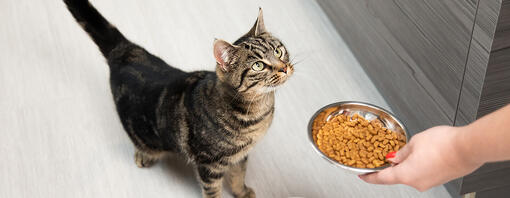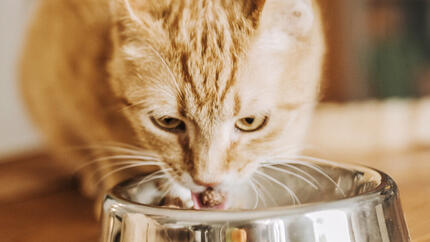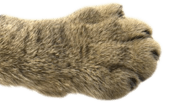What Should Cats Eat: The Basics of Cat Feeding and Feline Nutrition

As a cat lover, you’ll want your furry friend to lead a long, healthy, happy and active life. One of the best ways to achieve this is by making sure your cat’s diet has the right balance of the five major nutrient groups: protein, fats & oils, vitamins, minerals and carbohydrates.
Cats are ‘obligate carnivores’, which means they need meat in their diet, so unlike dogs, they can never be vegetarian or vegan. Felines rely on protein as their main source of energy, and need higher levels of protein in their diet than dogs. Not only is meat a ready source of protein, it also provides three essential nutrients that cats can’t live without: taurine (for heart and vision), arachidonic acid (for skin and coat health) and Vitamin A (for coat and vision).
At Purina, we’re passionate about providing the best diets for cats and ensuring that they get all the nutrition they need to thrive. That’s why we’ve created this article to give you all the information you need about feeding your cat.
Keep reading to find out all the essential elements that make up their diet and how much to feed your cat.
The essential elements of your cats diet
To keep them fit and healthy, you need to feed your cat the correct balance of all essential nutrients. A good-quality, complete cat food should be carefully formulated to provide them with the perfect balance of all the nutrients they need to thrive while, at the same time, still being delicious to eat. For the best diet for your cat, make sure they’re getting all of the following:
Water is essential for all living beings, and your cat is no different. Even though cats were originally desert animals and because of that are naturally very good at concentrating their urine, they can end up with bladder problems and cystitis if they don’t drink enough water. Make sure your cat can access plenty of clean, fresh drinking water, from an appropriate bowl for your cat or water fountain, throughout the day and night.
You’ve probably noticed that your cat loves to drink water from unusual sources like dripping taps or shower trays, but those should never replace an easily accessible source of constant fresh, clean water. Their water bowl should be placed a little distance away from their food bowl wherever possible, and well away from their litter tray. If you have an older cat with reduced mobility, put a water bowl in every room they spend time in so they can easily access it without too much effort wherever they are.
If you notice that your cat is drinking more or has suddenly started drinking from unusual places, it may mean they have a medical condition that’s causing excessive thirst so discuss this with your vet.
Cats use protein, made from amino acids, as their main source of energy. As cats can’t make these basic nutritional building blocks in their own bodies, they have to rely on getting specific essential amino acids in their diets. Feeding your cat a complete and balanced cat food should provide them with all the essential amino acids they need to form and maintain healthy muscle, skin and fur, as well as being a key part of their immune system. If your cat doesn’t get enough protein, they can end up with poor growth, loss of muscle bulk, poor coat condition and increased risk of infection through a poor immune system.
Fats, made from small units called fatty acids, provide 'fuel' to keep your cat active, as well as insulation and protection of their internal organs. Essential fatty acids, such as omega-3 and omega-6, are vital for keeping your cat’s skin and coat healthy and are an important part of your cat’s nutrition. Without them your cat could develop poor skin and coat condition.
Although carbohydrates (starch and fibre) are not an essential part of your cat’s diet, they do provide a readily available energy source. Prebiotics (soluble fibres) also help maintain a healthy gut by promoting good bacteria, while insoluble fibres promote normal intestinal function and a good stool quality.
Minerals, like calcium and phosphorous, are essential for strong, healthy teeth and bones so your cat’s diet needs to include the right quantities and right balance of each. This is important for all cats at all life stages – and especially so if they’re pregnant and growing kittens!
Sodium, chloride, magnesium and potassium, as well as zinc, copper and iron are also important minerals in cats’ diets. Feeding your cat good-quality, complete cat foods will provide the right balance of minerals. Balance is very important – too much of one mineral can lead to a deficiency in another.
Vitamins are needed, in small amounts, to promote your cat’s growth, normal vision, healthy skin and coat, wound healing and a healthy nervous system. They’re involved in the metabolism of fats, proteins and carbohydrates, and vitamins C and E are also important as antioxidants. Fat-soluble vitamins (A, D, E and K) are stored in your cat’s fatty tissues, but water-soluble vitamins (B complex and C) are not stored in the body, but passed out in your cat’s urine.
Feeding your cat moist or ‘wet’ food
Moist or ‘wet’ food comes in cans, foil trays or pouches. When feeding your cat moist or wet food, always serve it at room temperature to allow your cat to get the most enjoyment from the textures and smells.
It’s sometimes easy to overlook how important scent is to your cat – and this is a key part of a food’s appeal.
Once opened, cover any remaining portions and store them in the fridge for no more than 24 hours – and remember, the food will need to reach room temperature again for the next meal, so take it out of the fridge in plenty of time before serving. Wet food shouldn’t sit around uneaten for more than an hour as it will become unappetising and could attract bacteria, resulting in tummy upsets.
Feeding your cat complete dry foods
Dry foods are one of the best diets for cats. Their kibbles contain the right balance of nutrients and have a crunchy texture that can help keep your cat's teeth healthy. They are also more concentrated with nutrients than moist foods, so you only need to serve small helpings.
Whether you’ve decided to feed wet or dry food, read the label to check that it is a 'complete' food rather than 'complementary', otherwise you might be buying a snack/treat instead of a balanced meal!
If you feed a dry food, make sure your cat has plenty of fresh water, as dry food contains less moisture than wet food.
Can a Cat Eat Dog Food?
Despite their appearance, dry cat food and dry dog food are not the same. The dietary needs of cats and dogs are very different, so dog food is not suitable for cats and cat food is not suitable for dogs.
How do you change a cat’s food?
If you decide to change your cat’s food to a different type or brand, introduce the new food gradually over a period of seven to ten days. For cats it is best to put out two bowls, one with the old food and one with the new, so your cat has the opportunity to taste both.
Our article on feeding an adult cat can give you more advice on how to change your cats food appropriately.
Homemade cat food
The idea of preparing a special homemade meal for your cat can sound like a labour of love, but unfortunately it isn’t recommended. It’s very difficult to provide the best cat diet using home cooked or raw foods as some ingredients have very high or low quantities of essential nutrients.
Raw meat can also contain parasites and bacteria, such as Salmonella, which can make your cat (and you) ill so, as a cat owner, you need to pay particular attention to hygiene if you decide to feed a raw diet. Be very careful too about bones as these can splinter and even lodge in your cat’s intestine.
Find out more about human food for you cat including Can Cats Eat Rice, and whether it has any nutritional value?
When to Consider Using Cat Supplements
A high quality, complete and balanced diet is the key to good health. For most cats this will be sufficient and give them all the nutrients they need. However, some cats may need some extra support at times in their life, such as when they experience stress or to support a particular need such as healthy joints. In this case, food supplements, such as those formulated to complement a complete diet, can help to provide additional support. Your vet will be able to advise you if these are necessary and recommend as appropriate.
These may contain ingredients such as omega fatty acids to support skin and coat health, prebiotics, probiotics or postbiotics to help support immunity or B vitamins to support energy release and vitality in older pets. Moreover, supplements targeted at helping a cat’s hydration or supporting intestinal health and microflora balance are great assets to be used when needed.
How Much Should I Feed My Cat?
If you’re wondering how much to feed a cat, you’ll firstly need to bear in mind their breed, activity and lifestyle. A good place to start is by following the feeding guidelines on the pack as these give you approximate guidelines on how much to feed your cat. However, these are only a guideline, and the actual amount needed will vary from cat to cat depending on things such as their size or activity level.
Healthy treats or snacks are fine for your cat, and can be used in conjunction with enrichment toys to encourage exercise and give mental stimulation, but reduce their main meals slightly if you do give them treats to avoid overfeeding! If you feed dry food, you could use some of your cat’s daily rations in this way to further watch their waistline! Monitor your cat’s body condition score using the Purina body condition tool for cats and use this as a basis to adjust the amount of food you feed your cat.
That’s our guide to feeding your cat and getting the balance right. Want to find out more about feeding your adult cat? Read our article on how to feed a cat that’s not eating, next.
















